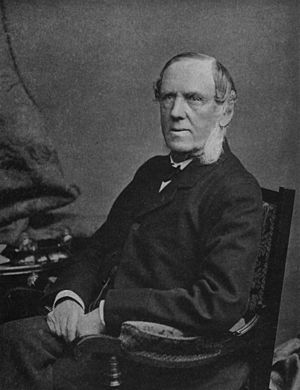George Dixon (MP) facts for kids
Quick facts for kids
George Dixon
|
|
|---|---|

George Dixon
|
|
| Member of Parliament for Birmingham Edgbaston |
|
| In office 1885–1898 |
|
| Preceded by | New constituency |
| Succeeded by | Francis Lowe |
| Member of Parliament for Birmingham |
|
| In office 1867–1876 |
|
| Preceded by | William Scholefield |
| Succeeded by | Joseph Chamberlain |
| Personal details | |
| Born | 24 January 1820 Gomersal, Yorkshire, England |
| Died | 24 January 1898 (aged 78) Edgbaston, Birmingham, England |
| Political party | Liberal / Liberal Unionist |
George Dixon (born in 1820, died in 1898) was an important English politician. He was first part of the Liberal Party, then the Liberal Unionist Party. He worked in local government in Birmingham and was a Member of Parliament (MP) for many years. George Dixon is best known for his strong belief that all children should get an education.
Contents
George Dixon's Life Story
George Dixon was born in 1820 in Gomersal, Yorkshire. He went to Leeds Grammar School. He also learned French while living in France. In 1838, he moved to Birmingham with his brother. There, he joined a company called Rabone Brothers, which was a firm of merchants.
He became a partner in the company in 1844. Later, he became the head of the firm. He worked there for his entire life.
Entering Politics
In 1863, Dixon started his political career. He became a councillor for Edgbaston in Birmingham. In November 1866, he was elected Mayor of Birmingham.
In July 1867, he left his role as Mayor. He decided to run for a seat in Parliament for Birmingham. This happened after the death of another politician, William Scholefield. On July 23, 1867, George Dixon was elected as a Member of Parliament (MP).
In 1870, he was elected to the School Board. He became its chairman in 1876. He stepped down from Parliament at that time because his wife was ill. He left the School Board in 1896. In 1885, he became an MP again, this time for Edgbaston. He continued to serve in Parliament until he died in 1898.
Education for All Children
One of George Dixon's first big achievements as Mayor was in early 1867. He held a private meeting at his home. He invited important people from the town. They talked about how to fix the problem of many children not getting an education.
Forming Education Societies
In March, a public meeting was held at the Birmingham Town Hall. At this meeting, the Birmingham Education Society was created. It was similar to groups already started in Manchester and Salford. This society collected money to help pay for some children's school fees. It also helped people understand why education was so important.
These Education Societies helped prepare the way for a bigger group. This new group was called the National Education League. It started in Birmingham in 1869. George Dixon was its chairman. Other important people like Joseph Chamberlain and Jesse Collings also supported it.
Making Education Law
The League wanted a new law to be made. This law would give education to all children, no matter their background. After some political discussions and agreements, the Elementary Education Act 1870 was passed. This law met some of the League's goals. It also led to the election of the first School boards.
The League kept working for seven more years. Eventually, basic education (up to age 12) became free and required by law in England and Wales. In 1867, Dixon had tried to introduce a bill to create school boards. This was for areas that already had enough schools. However, his bill was not accepted at that time.
Technical Schools for Brighter Students
In 1884, Dixon started an interesting project. He created the Bridge Street Technical School. He bought an old building that used to belong to Cadbury's. He paid to turn it into a school himself. Then, he rented it to the school board for a very low price.
This school taught science and mechanics. It was for 400 of the smartest boys. They studied there for two years after they usually would have left school. This idea was very successful. It was copied in many other large towns across the country. It also led to the Technical Instruction Act. This law made it official how these types of schools would be paid for.
In 1888, the technical school moved to a new building. It was renamed the George Dixon Higher Grade School. Girls were also able to attend this school. Another similar school, Waverley Road Higher Grade School, was opened in Small Heath in 1892. It could teach 555 children.
George Dixon was made an honorary freeman of Birmingham in 1898. This was the same year he passed away.
George Dixon's Legacy
George Dixon started the Bridge Street Technical School in 1884. When it moved to a new building in 1888, it was renamed George Dixon Higher Grade School. Later, when it was rebuilt in 1906, it became simply George Dixon School. Today, its successor schools are George Dixon Primary School and George Dixon Academy in Edgbaston.
George Dixon also indirectly inspired a famous fictional character. PC George Dixon first appeared in the film The Blue Lamp (1950). This film was made by Sir Michael Balcon, who used to be a student at George Dixon School. The character later became famous in the TV series Dixon of Dock Green (1955–1976).
Family Life
In 1855, George Dixon married Mary Stansfeld. She was the sister of a politician named James Stansfeld. Mary passed away in 1885. George and Mary had three sons and five daughters. Their son, Arthur Stansfield Dixon, became an architect.
See also
- School board (England & Wales)
- Birmingham board schools
- National Education League

